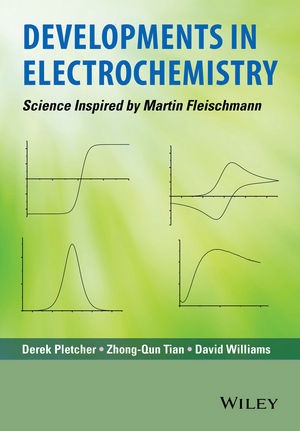Read more
Presents the state of electrochemistry research and highlights its potential with recent examples of its applications. The book both demonstrates how far-reaching the importance of Fleischmann's various works is, and overcomes the wrongly narrowed view on the cold fusion activities.
List of contents
List of Contributors xiii
1 Martin Fleischmann - The Scientist and the Person 1
2 A Critical Review of the Methods Available for Quantitative Evaluation of Electrode Kinetics at Stationary Macrodisk Electrodes 21
Alan M. Bond, Elena A. Mashkina and Alexandr N. Simonov
2.1 DC Cyclic Voltammetry 23
2.1.1 Principles 23
2.1.2 Processing DC Cyclic Voltammetric Data 26
2.1.3 Semiintegration 29
2.2 AC Voltammetry 32
2.2.1 Advanced Methods of Theory-Experiment Comparison 35
2.3 Experimental Studies 36
2.3.1 Reduction of [Ru(NH3)6]3+ in an Aqueous Medium 36
2.3.2 Oxidation of FeII(C5H5)2 in an Aprotic Solvent 40
2.3.3 Reduction of [Fe(CN)6]3. in an Aqueous Electrolyte 42
2.4 Conclusions and Outlook 43
References 45
3 Electrocrystallization: Modeling and Its Application 49
Morteza Y. Abyaneh
3.1 Modeling Electrocrystallization Processes 53
3.2 Applications of Models 56
3.2.1 The Deposition of Lead Dioxide 58
3.2.2 The Electrocrystallization of Cobalt 60
3.3 Summary and Conclusions 61
References 63
4 Nucleation and Growth of New Phases on Electrode Surfaces 65
Benjamin R. Scharifker and Jorge Mostany
4.1 An Overview of Martin Fleischmann's Contributions to Electrochemical Nucleation Studies 66
4.2 Electrochemical Nucleation with Diffusion-Controlled Growth 67
4.3 Mathematical Modeling of Nucleation and Growth Processes 68
4.4 The Nature of Active Sites 69
4.5 Induction Times and the Onset of Electrochemical Phase Formation Processes 71
4.6 Conclusion 72
References 72
5 Organic Electrosynthesis 77
Derek Pletcher
5.1 Indirect Electrolysis 79
5.2 Intermediates for Families of Reactions 80
5.3 Selective Fluorination 84
5.4 Two-Phase Electrolysis 85
5.5 Electrode Materials 87
5.6 Towards Pharmaceutical Products 88
5.7 Future Prospects 90
References 91
6 Electrochemical Engineering and Cell Design 95
Frank C. Walsh and Derek Pletcher
6.1 Principles of Electrochemical Reactor Design 96
6.1.1 Cell Potential 96
6.1.2 The Rate of Chemical Change 97
6.2 Decisions During the Process of Cell Design 98
6.2.1 Strategic Decisions 98
6.2.2 Divided and Undivided Cells 98
6.2.3 Monopolar and Bipolar Electrical Connections to Electrodes 99
6.2.4 Scaling the Cell Current 100
6.2.5 Porous 3D Electrode Structures 100
6.2.6 Interelectrode Gap 101
6.3 The Influence of Electrochemical Engineering on the Chlor-Alkali Industry 102
6.4 Parallel Plate Cells 105
6.5 Redox Flow Batteries 106
6.6 Rotating Cylinder Electrode Cells 107
6.7 Conclusions 108
References 109
7 Electrochemical Surface-Enhanced Raman Spectroscopy (EC-SERS): Early History, Principles, Methods, and Experiments 113
Zhong-Qun Tian and Xue-Min Zhang
7.1 Early History of Electrochemical Surface-Enhanced Raman Spectroscopy 116
7.2 Principles and Methods of SERS 117
7.2.1 Electromagnetic Enhancement of SERS 118
7.2.2 Key Factors Influencing SERS 119
7.2.3 "Borrowing SERS Activity" Methods 121
7.2.4 Shell-Isolated Nanoparticle-Enhanced Raman Spectroscopy 123
7.3 Features of EC-SERS 124
7.3.1 Electrochemical Double Layer of EC-SERS Systems 124
7.3.2 Electrolyte Solutions and Solvent Dependency 125
7.4 EC-SERS Experiments 125
7.4.1 Me
About the author
Derek Pletcher is Emeritus Professor at the University of Southampton. His research interests extend from fundamental electrochemistry, through electrochemical engineering to the industrial applications of electrolysis. He is the author of ~ 340 technical papers and ~ 30 reviews and has supervised the training of more than 90 postgraduate students. In 2010, he was awarded the prestigious Vittorio de Nora Medal by the US Electrochemical Society for his work related to the applications of electrochemistry. He is an elected Fellow of the Electrochemical Society (2005) and was awarded their Henry Linford Medal for Teaching Excellence in Electrochemistry (2006). He is a past Editor of the
Journal of Applied Electrochemistry (1980 - 85) and presently serves on the Editorial Boards of
Electrochimica Acta and
Electrochemical Communications.
Zhong-Qun Tian heads the Surface-enhanced Raman Spectroscopy and Nano-electrochemistry research group at Xiamen University. He graduated from the Department of Chemistry at Xiamen University in 1982 with a BSc and received his Ph.D in 1987 under advisor, Martin Fleischmann, FRS. He is a Fellow of International Society of Electrochemistry (ISE), 2010- ;Regional Representative (China) of International Society of Electrochemistry (ISE), 2007-2009; Fellow of Royal Society of Chemistry, UK, 2005- ; Council Member of Chinese Society of Micro/Nano Technology, 2005-; Guest Professor of Chemistry, Chinese University of Hong Kong, China, 2006-; Guest Professor of Chemistry, Univ. of Science and Technology of China, China, 2001-; Visiting Professor of Ecole Normal Superior, Paris, France, 2008/9. He has over 310 papers, five chapters in encyclopaedias and books and has edited two special journal issues.
David Williams is Professor of Electrochemistry at the University of Auckland, NZ. His research covers electrochemistry and corrosion science. He is a graduate of the University of Auckland and developed his research career in electrochemistry and chemical sensors at the UK Atomic Energy Research Establishment, in the 1980s. He became Thomas Graham Professor of Chemistry at UCL in 1991. He joined the faculty of the Chemistry Dept at Auckland University in 2006. He is an Adjunct Professor at Dublin City University. He is a Visiting Professor at UCL, and University of Southampton, and Honorary Professor of the Royal Institution of Great Britain. He has published around 200 papers in international journals, and is the inventor of around 40 patents.
Summary
* Presents the state of electrochemistry research and highlights its potential with recent examples of its applications. * The book both demonstrates how far-reaching the importance of Fleischmann s various works is, and overcomes the wrongly narrowed view on the cold fusion activities.

